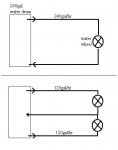this should answer you
below, you still have only one source of water no matter how many times you "tap" the source.
you would need three drums of water to have three phase.
If you have a bank account with two debit cards , one for you and the wife, its still one bank account.
In three phase you need three separate coils on the secondary of the transformer (three bank accounts.
In residential applications there is one secondary coil and it is tapped twice with a common N / G.
It would be a lot easier to call it single phase "dual tap" source rather than the misnomer of two phase. Ive yet to physically see two phase
below, you still have only one source of water no matter how many times you "tap" the source.
you would need three drums of water to have three phase.
If you have a bank account with two debit cards , one for you and the wife, its still one bank account.
In three phase you need three separate coils on the secondary of the transformer (three bank accounts.
In residential applications there is one secondary coil and it is tapped twice with a common N / G.
It would be a lot easier to call it single phase "dual tap" source rather than the misnomer of two phase. Ive yet to physically see two phase
with respect to post 24 and 27, your source is still one drum of water no matter how many times you "TAP" into the source.
if you want another phase, your going to need another drum.
Attachments
Last edited:


